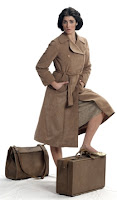Hace unos días, me fue a visitar Ernesto Byrne a mi oficina e hicimos recuerdos de nuestros tiempos de Braniff. Llegamos a la conclusión que BI fue una gran compañía, que nos marcó a todos, tal vez de manera distinta a cada uno de nosotros, pero ninguno de nosotros es indiferente a la gran experiencia de haber trabajado en BI.
Comparto con ustedes, un artículo que se publicó en la evista TIME, el 15 de abril de 1966 (debemos haber estado todos en el colegio en esa época) y es increíble ver la tremenda energía que tenía Harding Lawrence, para dirigir los destinos de una compañía que llegó a ser la octava compañía más importante de los Estados Unidos.
Quiero agradecer a Christine Decker por su contribución a este Blog, con las fotos de los uniformes.
Finalmente les pido que si quieren subir alguna foto o comentario, que me lo hagan llegar a mi e mail hdonosop@gmail.com y lo verán en el Blog.
Un cariñoso abrazo,
Hugo Donoso Palacios





"Colors Are Fun"
On Braniff International planes, women passengers have a particular problem: trying to pick clothes whose colors won't clash with the vivid hues of Braniff. Since last fall, in a major departure from the traditional white or silver commercial airlines, Braniff has been painting its jets any of seven assorted colors: lemon, beige, ocher, turquoise, orange, light and dark blue. Aircraft interiors are a kaleidoscope of orange, yellow, blue, brown, grey, red and green. Braniff hostesses wear uniforms that include lime topcoats, pink and yellow or pink and blue shift dresses and hyacinth culottes, all styled by Italian Couturier Emilio Pucci.
Rash of Jokes. Inevitably, the hostesses have become known among Bonded birdmen as Pucci Galores. And the multicolor fleet has raised a rash of jokes, such as the one about the airport controlman who radioed a Braniff pilot: "O.K., dearie, take off."
The last laugh, however, seems to belong to Braniff President Harding Lawrence, 45, who took over the airline a year ago last week and is responsible for the color splash. Braniff is getting more attention than other airlines, and operating statistics show it. Passengers increased 18% last year to 3,370,000; revenues also rose 18%, to $129 million, and earnings were up 58% to $9,400,000. Within the year, Braniff stock rose from $25 to $125, and stockholders last week happily approved a two for one split.
Lawrence, who came to Braniff from Continental Airlines, turned to the color brush as a quick way to paint over a dowdy image. Between 1945 and 1964, Braniff had slipped from fifth to ninth place among U.S. trunk airlines, was notorious for late flights, sloppy service and shoddy equipment. Its routes included everything from long flights to Buenos Aires to costly Texas puddle jumps, but the airline had not won a new route for ten years and was barely making money. "Flying had become a crawling bore," says Lawrence today. "But flying should be fun—and colors are fun." When Jack Tinker & Partners, the ad agency that Lawrence hired while he was increasing his advertising budget from $2,500,000 to $6,500,000, suggested colored airplanes, Lawrence leaped at the idea.
Nights & Days. Much more than spray guns went into Lawrence's new-look campaign. Braniff was the first U.S. airline to put into operation the relatively small short-run jet aircraft —in Braniff's case the BAC One-Eleven —providing places like Sioux Falls, S. Dak., with commercial jet service for the first time. Needing only a 48% passenger load for Braniff to break even, the 63-seat BAG One-Eleven has averaged 61.1%. In addition, Lawrence put Braniff's four-engine Boeing jets on a new schedule of daytime flying and nighttime maintenance. As a result, they now fly 11½ hours daily instead of eight, and Braniff's profit sheets show the difference.







